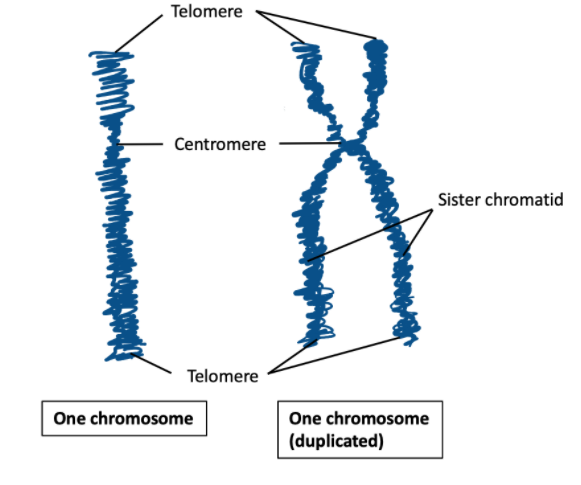
What is a telomere? State its function?
Answer
487.2k+ views
Hint: Telomeres are a distinctive feature of the chromosome that is found in the chromosomes. They contain DNA sequences that are repeated over and over. They can only work in the presence of the enzyme, called telomerase.
Complete answer:
A telomere is a region of repetitive nucleotide sequence that is associated with specialized proteins which are present at the end of the linear chromosome. It is one of the genetic features that is found common in eukaryotes. They protect the terminal region of the chromosomal DNA from progressive degradation and also ensure the integrity of the linear chromosome thus preventing the DNA repair system from mistaking the end of the DNA strand for a double-strand break.

In humans, the sequence of telomere is TTAGGG and this sequence is repeated about 3,000 times and it can reach up to 15,000 base pairs in length. They are mediated by the enzyme telomerase along with the associated proteins that protect the blunt ends of the DNA and prevent the cell from triggering a DNA damage response. The length of it might help in determining the lifespan of the cell and the organism
When they reach a critical limit in length, the cell undergoes senescence. Certain factors that are associated with specific lifestyles may expedite telomere shortening by inducing damage to DNA, thus affect our health and lifespan.
They serve three major roles :
1. They help to organise each of our 46 chromosomes in the nucleus present in our cell.
2. They protect the end of the chromosomes as they form a cap around them. If the telomeres were not there, our chromosomes may end up sticking to other chromosomes.
3. They also help in the proper replication of chromosomes during cell division.
Note: The length of telomere shortens with age. The progressive shortening of telomeres leads to senescence and thus affects our health and lifespan. Shorter telomeres are associated with an increased incidence of diseases. Better choice of diet and regular exercise has the potential to reduce the rate of telomere shortening or it may delay the onset of age-associated diseases and can increase lifespan.
Complete answer:
A telomere is a region of repetitive nucleotide sequence that is associated with specialized proteins which are present at the end of the linear chromosome. It is one of the genetic features that is found common in eukaryotes. They protect the terminal region of the chromosomal DNA from progressive degradation and also ensure the integrity of the linear chromosome thus preventing the DNA repair system from mistaking the end of the DNA strand for a double-strand break.

In humans, the sequence of telomere is TTAGGG and this sequence is repeated about 3,000 times and it can reach up to 15,000 base pairs in length. They are mediated by the enzyme telomerase along with the associated proteins that protect the blunt ends of the DNA and prevent the cell from triggering a DNA damage response. The length of it might help in determining the lifespan of the cell and the organism
When they reach a critical limit in length, the cell undergoes senescence. Certain factors that are associated with specific lifestyles may expedite telomere shortening by inducing damage to DNA, thus affect our health and lifespan.
They serve three major roles :
1. They help to organise each of our 46 chromosomes in the nucleus present in our cell.
2. They protect the end of the chromosomes as they form a cap around them. If the telomeres were not there, our chromosomes may end up sticking to other chromosomes.
3. They also help in the proper replication of chromosomes during cell division.
Note: The length of telomere shortens with age. The progressive shortening of telomeres leads to senescence and thus affects our health and lifespan. Shorter telomeres are associated with an increased incidence of diseases. Better choice of diet and regular exercise has the potential to reduce the rate of telomere shortening or it may delay the onset of age-associated diseases and can increase lifespan.
Recently Updated Pages
Why are manures considered better than fertilizers class 11 biology CBSE

Find the coordinates of the midpoint of the line segment class 11 maths CBSE

Distinguish between static friction limiting friction class 11 physics CBSE

The Chairman of the constituent Assembly was A Jawaharlal class 11 social science CBSE

The first National Commission on Labour NCL submitted class 11 social science CBSE

Number of all subshell of n + l 7 is A 4 B 5 C 6 D class 11 chemistry CBSE

Trending doubts
Differentiate between an exothermic and an endothermic class 11 chemistry CBSE

10 examples of friction in our daily life

One Metric ton is equal to kg A 10000 B 1000 C 100 class 11 physics CBSE

Difference Between Prokaryotic Cells and Eukaryotic Cells

1 Quintal is equal to a 110 kg b 10 kg c 100kg d 1000 class 11 physics CBSE

State the laws of reflection of light




